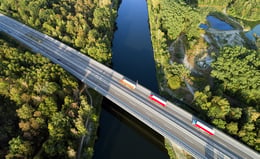The 5 Challenges Transport Networks Face
Brian Hoey - May 12, 2020

It’s always tough to say how much transport and logistics networks will really change from year to year. New technology and global trends are always competing against the forces of inertia and habit, and the result is that technology adoption lags behind predictions in some sectors while exceeding our expectations in others. This year, with the unprecedented disruption to the global logistics network caused by the coronavirus, it’s even harder to predict what transportation managers will find themselves grappling with in only a few months’ time.
On the one hand, the folks at Deloitte suggest that the current crisis might become a “black swan event” that causes global supply chains to evolve rapidly. We’re already seeing any number of weaknesses latent in the way that many logistics routes are structured, and the hope is that businesses will begin to address those weaknesses in a systematic way—whether that’s with new technologies like the IoT (internet of things), new organizational tactics like S&OE (sales and operations execution), or something else along those lines. At the same time, it’s just as easy to imagine that some businesses will do their best to act like nothing has happened and get back to business-as-usual as soon as they’re able.
Considering that most of the weaknesses we’re seeing in the global supply chain far pre-date this present crisis, it doesn’t make much sense from our perspective to go back to business as usual. That brings us to an important question: what changes should be in the works for the modern supply chain, and what challenges will we have to overcome to make them happen?
1. Global Uncertainty
Recently, we’ve seen a spate of disruptions along every wrung of the supply chain, including closed ports, driver shortages, and severely impacted supply networks. At a baseline level, to run a successful transport network in 2020 you’ll need to find a way to overcome these disruptions and disruptions like them that will continue to emerge. To do so, your most important asset will be your flexibility. If you’re relying on static transport routes for your cargo or that of your clients—routes that basically stay the same from one shipment to another—you’ll be much more susceptible to things like delays and disruptions at the ports you rely on. If by contrast, you have enough visibility and an agile enough planning flow that you can reroute shipments as needed on the fly (leveraging all of the various touchpoints as needed based on your most up-to-date data), then you stand a much better chance of staying on your feet in spite of change and disruption.
2. The Amazon Effect
The importance of flexibility is only increased by the way that consumer expectations have been changing for the past few years. This is in large part due to the so-called Amazon Effect, by which consumers have gotten used to much faster shipping turnaround times. In spite of the global logistics situation at the moment, it’s unlikely that consumers will adjust their expectations back to pre-Amazon levels any time soon—meaning that one of the most serious hurdles that transport networks have to face this year is how to speed up shipping time without becoming more susceptible to disruption. This is usually a matter of supply chain visibility and real-time planning capabilities. These things have been real value-drivers for years now, but they’ll increasingly become mission critical as transport networks are increasingly judged by the Amazon standard.
3. Technology Integration
So far, we’ve talked about two challenges that are going to force manufacturers, shippers, freight forwarders, and other supply chain players to adapt. But what about the adaptations themselves? What challenges might you have to overcome to respond effectively to the hurdles we outlined above? The first, and perhaps most important, is technology integration. When you're trying to remain agile and give yourself a chance to change plans on the fly, data silos are the kiss of death. You need to know where your hubs, warehouses, cross-docks, and trucks are at any given moment—and you need to know how they’re already being utilized—in order to make decisions on the fly. That means that you need to integrate the right technology into your own software ecosystem in order to collect that information in real-time. By the same token, you need to be able to analyze the data you’re receiving in real-time and turn it into actionable insights on a moment’s notice—something that requires advanced analytics integration in order to become truly data-driven.
4. Increasing End-to-End Visibility
Like we said above, data silos are the kiss of death when it comes to thinking and acting on your feet within a volatile value chain. Silos are limited to the bounds of your own operation, however. You also need access to data from suppliers, and even customers, in order to achieve true end-to-end visibility. To make this a reality, you’ll want to strive for supply chain integration, such that your IT is connected to the IT ecosystems in use at other touchpoints on the chain. This can require a fair bit of buy-in acquisition (to say nothing of choosing the right technology) but the result is that you’ll have much easier time avoiding the kinds of disruptions we’re seeing right now, in which businesses with first and second tier suppliers in highly-impacted areas have been completely blindsided by parts outages. With an integrated supply chain, you’ll be able to see disruptions like these coming, and you’ll be able to visualize the field of possible alternatives at a moment’s notice.
5. Boosting Responsiveness
Of course, overcoming these challenges doesn’t mean much if you can’t operationalize your analytics and your visibility into more agile decision making. As such, the more transport networks and their administrators adapt technologically, the more they’ll need to do the same from an operational perspective. This will mean empowering the right people to people to make the right data-driven decisions as new situations unfold. In other words, you’ll need to put systems in place that allow you to be proactive, rather than reactive. This might mean setting up an S&OE workflow that empowers planners to make minute adjustments to transport plans based on new information. By the same token, it might involve using advanced analytics to periodically run optimizations on the networks themselves to eliminate waste and redundancy. However you do it, you’ll want to put yourself in a position where managing unexpected is practically second nature.
If you want to learn more get your Guide to Logistics 4.0
In this Guide you will learn:
-
Why a strategic process in transportation planning is a top priority for digitalization
-
What megatrends will increase supply chain volatility
-
How to manage it
LATEST POSTS
- Understand Circular Economy in The Manufacturing Industry
- How Can Industry 4.0 IT Integration Be Achieved Smoothly?
- The Significance of Order Sequencing in Discrete Manufacturing
- How to improve your Supply Chain Management: The Power of Control Towers
- Optimizing Human Resource Scheduling in Manufacturing: A Technological Approach



